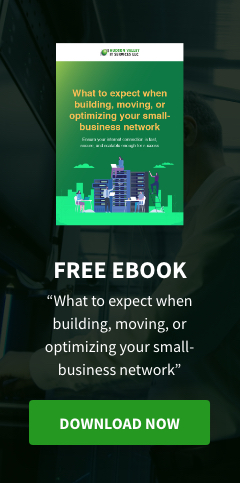Evaluating potential IT partners? It may be inevitable to get bogged down in all the confusing acronyms and jargon. While business owners should always be wary of vendors who can’t seem to speak in plain English, some of the terminology is still unavoidable. That’s why we’ve compiled a list of common terms that you might encounter.
Cloud computing
Cloud computing is a distributed computing model in which workloads and application hosting are managed in a remote data center as opposed to in-house. The most common example of cloud computing is web-based email. Today, faster internet connections make it possible to host complex applications and even entire desktop experiences remotely.
Compliance-as-a-service
Every business faces compliance obligations, with some industries facing stricter regulations than others. Healthcare providers, for example, must abide by data-protection acts like HIPAA and HITECH, while any company that stores payment card information is subject to PCI DSS. The complexities of legal compliance often make it necessary for small- to medium-sized businesses (SMBs) to partner with a vendor that takes care of these matters for them.
Data breach
Digital data is now the most valuable commodity on the planet, which is why cybercriminals are constantly looking for ways to steal it. Data breaches are typically carried out using malicious software, social engineering scams, or a combination of the two. More often than not, victims don’t discover data breaches until months after they’ve happened, hence the need for a strong cybersecurity strategy backed up by proactive support.
Hybrid IT
Cloud computing undoubtedly offers many benefits, but there are some computing workloads that are still better off being handled by local resources. Examples include bandwidth-intensive or very high-performance applications and other specialized workloads. Server colocation is another popular option for companies that want to enjoy the benefits of the cloud while keeping their systems separate from other users. Hybrid IT refers to a merging of such models.
Intrusion detection and prevention systems (IDS/IPS)
Firewalls have long played a central role in digital security, both at home and in the workplace. In enterprise environments, however, relying on a firewall isn’t enough. Intrusion detection and prevention systems take protection a step further by using rule- and behavior-based detection to proactively guard against threats. These features are often included along with firewalls as part of a unified threat management (UTM) solution.
Remote support
IT downtime is one of the major causes of lost productivity, and the costs are getting higher all the time as businesses and customers alike grow increasingly reliant on technology. That’s why organizations need to take a proactive approach to IT support, complete with round-the-clock monitoring and help desk assistance. IT support providers are obligated under the terms of their service level agreements (SLAs) to respond to requests by certain deadlines.
Risk management
All forms of technology present both risks and opportunities, so there’s no such thing as a business that’s completely safe from a cyberattack. Risk management refers to the strategic process of bringing the risk down to an acceptable level by conducting a risk analysis and a business impact analysis (BIA), and implementing the steps necessary to reduce the risk and prepare for worst-case scenarios.
Technology alignment
Many people obsess over chasing the latest technology without giving much thought to how it will actually benefit them. Business leaders cannot afford to do this, lest technology assets turn into a costly liability. Technology alignment means strategically matching IT solutions to specific business goals and challenges. A successful technology alignment is crucial in any digital transformation program.
Virtualization
Virtual computing resources are defined by software and run on top of the underlying hardware layer to increase efficiency, portability, and redundancy. A huge variety of computing tasks can be virtualized, from servers to networks to end-user desktop experiences. In the age of cloud computing, virtualization allows companies to build an entirely software-defined IT architecture that’s hosted in a remote data center, operating independently of any in-house hardware.
Virtual private networking (VPN)
A VPN is a software-defined network that sits on top of a public network, typically the internet itself. Enterprise-grade VPNs automatically encrypt all data sent between the local network and the internet, instead of relying solely on encryption protocols like transport layer security (TLS). A VPN also allows users to appear as though they’re connecting from the same location as the VPN server, eliminating localized browsing restrictions and variations.
Hudson Valley IT Services provides managed IT services aligned to suit the unique needs of your business. Call us today to find out how.
Like This Article?
Sign up below and once a month we'll send you a roundup of our most popular posts


